Zuofeng Zhong
Effective Transfer of Pretrained Large Visual Model for Fabric Defect Segmentation via Specifc Knowledge Injection
Jun 28, 2023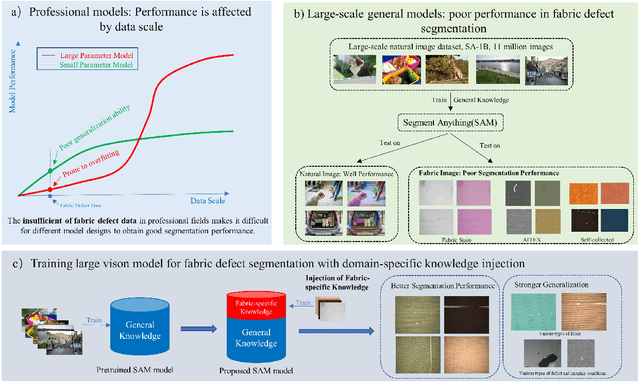
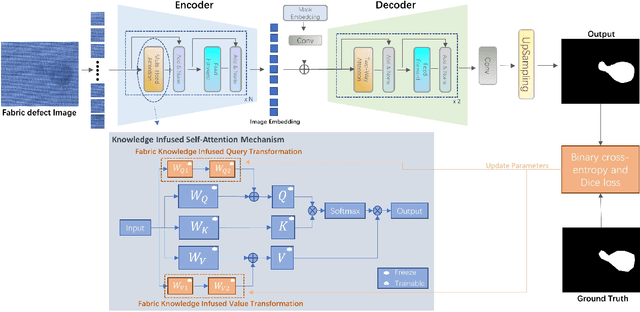
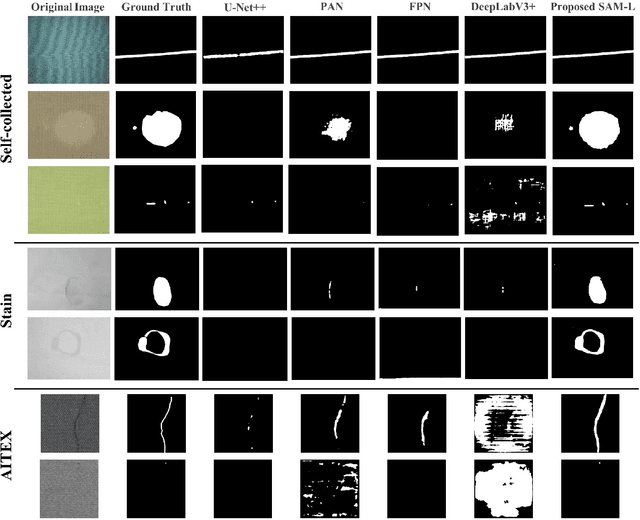

Abstract:Fabric defect segmentation is integral to textile quality control. Despite this, the scarcity of high-quality annotated data and the diversity of fabric defects present significant challenges to the application of deep learning in this field. These factors limit the generalization and segmentation performance of existing models, impeding their ability to handle the complexity of diverse fabric types and defects. To overcome these obstacles, this study introduces an innovative method to infuse specialized knowledge of fabric defects into the Segment Anything Model (SAM), a large-scale visual model. By introducing and training a unique set of fabric defect-related parameters, this approach seamlessly integrates domain-specific knowledge into SAM without the need for extensive modifications to the pre-existing model parameters. The revamped SAM model leverages generalized image understanding learned from large-scale natural image datasets while incorporating fabric defect-specific knowledge, ensuring its proficiency in fabric defect segmentation tasks. The experimental results reveal a significant improvement in the model's segmentation performance, attributable to this novel amalgamation of generic and fabric-specific knowledge. When benchmarking against popular existing segmentation models across three datasets, our proposed model demonstrates a substantial leap in performance. Its impressive results in cross-dataset comparisons and few-shot learning experiments further demonstrate its potential for practical applications in textile quality control.
Adaptive Locality Preserving Regression
Jan 03, 2019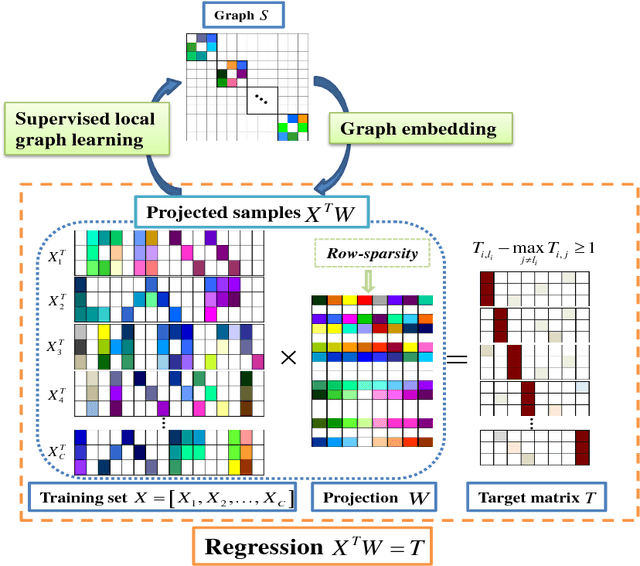
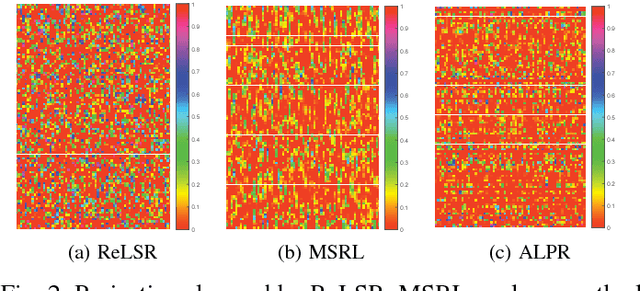
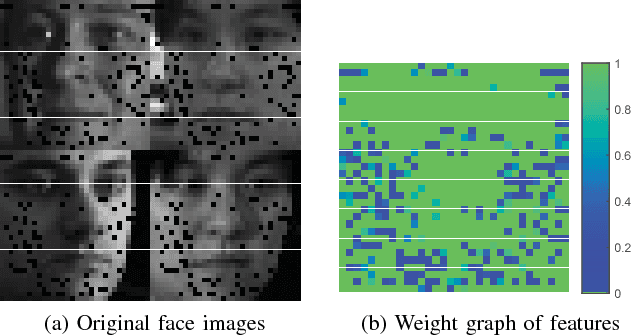

Abstract:This paper proposes a novel discriminative regression method, called adaptive locality preserving regression (ALPR) for classification. In particular, ALPR aims to learn a more flexible and discriminative projection that not only preserves the intrinsic structure of data, but also possesses the properties of feature selection and interpretability. To this end, we introduce a target learning technique to adaptively learn a more discriminative and flexible target matrix rather than the pre-defined strict zero-one label matrix for regression. Then a locality preserving constraint regularized by the adaptive learned weights is further introduced to guide the projection learning, which is beneficial to learn a more discriminative projection and avoid overfitting. Moreover, we replace the conventional `Frobenius norm' with the special l21 norm to constrain the projection, which enables the method to adaptively select the most important features from the original high-dimensional data for feature extraction. In this way, the negative influence of the redundant features and noises residing in the original data can be greatly eliminated. Besides, the proposed method has good interpretability for features owing to the row-sparsity property of the l21 norm. Extensive experiments conducted on the synthetic database with manifold structure and many real-world databases prove the effectiveness of the proposed method.
* The paper has been accepted by IEEE Transactions on Circuits and Systems for Video Technology (TCSVT), and the code can be available at https://drive.google.com/file/d/1iNzONkRByIaUhXwdEhOkkh_0d2AAXNE8/view
Incomplete Multi-view Clustering via Graph Regularized Matrix Factorization
Sep 17, 2018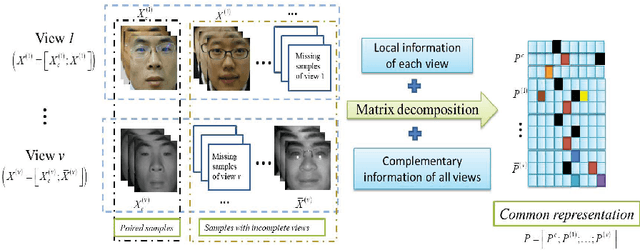


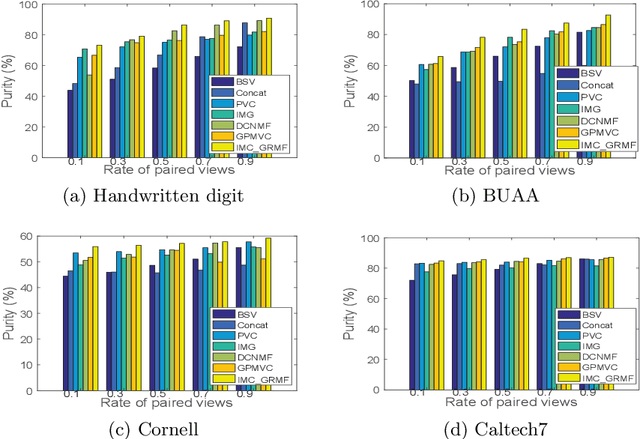
Abstract:Clustering with incomplete views is a challenge in multi-view clustering. In this paper, we provide a novel and simple method to address this issue. Specifically, the proposed method simultaneously exploits the local information of each view and the complementary information among views to learn the common latent representation for all samples, which can greatly improve the compactness and discriminability of the obtained representation. Compared with the conventional graph embedding methods, the proposed method does not introduce any extra regularization term and corresponding penalty parameter to preserve the local structure of data, and thus does not increase the burden of extra parameter selection. By imposing the orthogonal constraint on the basis matrix of each view, the proposed method is able to handle the out-of-sample. Moreover, the proposed method can be viewed as a unified framework for multi-view learning since it can handle both incomplete and complete multi-view clustering and classification tasks. Extensive experiments conducted on several multi-view datasets prove that the proposed method can significantly improve the clustering performance.
Local Multiple Directional Pattern of Palmprint Image
Jul 21, 2016


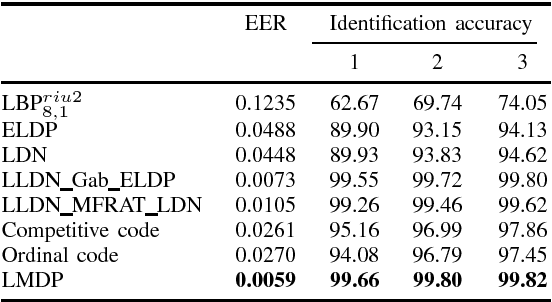
Abstract:Lines are the most essential and discriminative features of palmprint images, which motivate researches to propose various line direction based methods for palmprint recognition. Conventional methods usually capture the only one of the most dominant direction of palmprint images. However, a number of points in palmprint images have double or even more than two dominant directions because of a plenty of crossing lines of palmprint images. In this paper, we propose a local multiple directional pattern (LMDP) to effectively characterize the multiple direction features of palmprint images. LMDP can not only exactly denote the number and positions of dominant directions but also effectively reflect the confidence of each dominant direction. Then, a simple and effective coding scheme is designed to represent the LMDP and a block-wise LMDP descriptor is used as the feature space of palmprint images in palmprint recognition. Extensive experimental results demonstrate the superiority of the LMDP over the conventional powerful descriptors and the state-of-the-art direction based methods in palmprint recognition.
 Add to Chrome
Add to Chrome Add to Firefox
Add to Firefox Add to Edge
Add to Edge